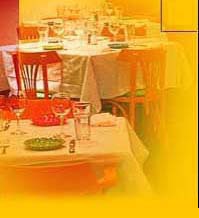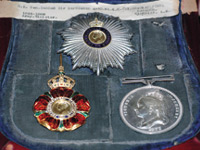


|
|
|
SARDAR Jayendra Rao Awad is the last of the Maratha nobility left in Gwalior. He is a businessman who supplies oxygen gas to hospitals and the steel industry and lives in an ancient and rambling haveli on Kapoo Road in the city�s Lashkar area. Once a year, on the festival of Dashera, Jayendra lives up to the grand legacy of his cultured ancestors. His family and he dress up in their traditional Maratha finery, wearing the anga and pagadi, sheathed sword by the side, and step out proudly to accompany the Scindia royals for a solemn puja that is followed by a traditional dinner. This has been the custom down the centuries. It was started by one of his forefathers and an erstwhile Scindia Maharaja. Jayendra is happy to continue the practise. It is the highpoint in the life of this Maratha who seems otherwise lost in the ways and beliefs of the North. When visitors come, as we of the UpperCrust did, Jayendra proudly traces his family tree back to the 18th century for them. He also darts excitedly into the inner rooms of the haveli, behind stone pillars, from where he emerges triumphantly bearing albums of sepia-tone photographs and dusty cases holding medals and other memorabilia. With these and the long-winding stories he has to narrate of Gwalior-Scindia-Awad history, Jayendra seems to be desperately clinging on to his aristocratic past. I was his sounding board, and over a glass of dreadful red Indian wine preceding an awesome meal of home-cooked Gwalior food, Jayendra told me all about his noble family the Sunday afternoon we were there.
He is a funny sort of man, somewhat irascible, very proper in his ways, almost British-like and with impeccable habits, but Maratha down to his roots and faithful to the royal family of Gwalior to his last breath. A Maratha caught in a time warp, I thought, who would have been happier perhaps in the days when the Awads were serving the Scindias in spirit and with sword. I was wondering what kind of family this might be when we drew up outside their old haveli. Trini Lopez was singing If I Had A Hammer. This was certainly not what I had expected. I was also not prepared for Jayendra�s handsome and strapping 21-year-old son who greeted us at the door with a soft-shoe shuffle. A flight purser with Spice Jet, he was dressed in kurta-pajama and sandals. �Hi, I�m Sam,� he said surprising us and grinning cheerfully.
The Awads also have a daughter, Yogini, who is happily married and settled down in Nagpur. It is left to Sam now to keep the family flag fluttering. Though he is seldom in Gwalior. Spice Jet is not one of the airlines that uses the tiny Gwalior airport and Sam comes home, his flight schedules permitting, once or twice a month only. When he is there, like he was the Sunday we visited the family, then it is time for celebration. For the Awads, God bless, celebration means a real feast. Music is played, wine bottles are opened, and a team of old family retainers lovingly stoke the kitchen fires. They dine heartily and do a grand table. Both Jayendra and Anjali are fond of cooking. Though for our lunch, Jayendra stayed out of the kitchen, and over drinks he bragged to me about how good he was at cooking an Italian dish with the local Sole fish. I marvelled at how a Maharashtrian living in Madhya Pradesh could have the enterprise to come up with a recipe for Italian cooking. The menu for lunch, fortunately, was not Italian. It was Gwalior food, the cuisine being a fusion of North Indian, Maharashtrian and Nepalese cooking. The Northern influence came from the region. But the Maharashtrian touch was because Gwalior had a sizeable population of Maharashtrians living there since forever and the Scindia Maharajas themselves were Maharashtrians. It is the Nepalese connection that is the foreign strain. Apparently, some of the daughters-in-law of the royal Gwalior family have been Nepalese princesses, and when they came over from Kathmandu they brought with them their culinary traditions and secrets, spices, and even cooks from their father�s palace. The Nepalese food they cooked for themselves got assimilated with the already concocted Gwalior cuisine. It is a now happy marriage of cooking styles, ingredients and flavours.
The other Gwalior speciality is the Non Mas, an unusual dish of chicken cooked in ghee with a rich, white almond-cashew gravy. The Nepalese Dahi Ande, hardboiled eggs in a spicy yogurt sauce, has a secret ingredient that is the Nepalese masala Jimoor. �It is optional,� said Anjali. The special Dashera dishes aside, the eating habits of the Gwalior Marathas are pretty austere, they satisfy themselves with dal-chawal and sabzi-phulkas. In the Awad haveli on Sardar Awad�s Bada, life and meals are more exciting, because Jayendra often threatens to go into the kitchen and make them his Italian Fish. As we left their residence, he was telling me about it me as he walked us to the gate, �You must come for dinner. I will see if there is any Sole available in the market. This Italian Fish dish is made in a cream sauce and garnished with potatoes and crispy spinach. You will like it.�
|

Home Page
About the mag
Subscribe
Advertise
Contact Us
 The Last Marathas!
The Last Marathas!
 His ancestor Dattaji Awad migrated from Maharashtra in 1759 with Maharaja Mahadji Scindia to fight the Battle of Panipat against the invading army of Emir Ahmed Shah Abdali of Afghanistan in 1761. The Marathas suffered a terrible beating and the Scindia forces and allies were defeated in the bloody war. That is all now part of history. But since then, the Awads have been happily living on in Gwalior, and generations of them continued to be treated with respect by the successive Scindia Maharajas. Jayendra is the current generation Awad of this noble lineage. He enjoys a cordial relationship with his present king, Maharaja Jyotiraditya Scindia, although he had closer ties with the latter�s father, the late Madhavrao Scindia. �I couldn�t attend Madhavrao�s funeral because I was so shocked when he died in that plane crash, that I had to be hospitalised,� Jayendra told me.
His ancestor Dattaji Awad migrated from Maharashtra in 1759 with Maharaja Mahadji Scindia to fight the Battle of Panipat against the invading army of Emir Ahmed Shah Abdali of Afghanistan in 1761. The Marathas suffered a terrible beating and the Scindia forces and allies were defeated in the bloody war. That is all now part of history. But since then, the Awads have been happily living on in Gwalior, and generations of them continued to be treated with respect by the successive Scindia Maharajas. Jayendra is the current generation Awad of this noble lineage. He enjoys a cordial relationship with his present king, Maharaja Jyotiraditya Scindia, although he had closer ties with the latter�s father, the late Madhavrao Scindia. �I couldn�t attend Madhavrao�s funeral because I was so shocked when he died in that plane crash, that I had to be hospitalised,� Jayendra told me.
 Sam, we discovered when proper introductions were subsequently made, was short for Sambhaji, a regular Maratha name. Jayendra�s wife trooped out next, a large, pleasant and attractive Maharashtrian woman named Anjali. Her title in Gwalior is Lady Anjali
Devi Awad. And this Lady runs her own school out of one big section of the haveli. It is called The Orchid�s High School and has 600 students from playgroup upto Std XI. Jayendra is the president of the institution.
Sam, we discovered when proper introductions were subsequently made, was short for Sambhaji, a regular Maratha name. Jayendra�s wife trooped out next, a large, pleasant and attractive Maharashtrian woman named Anjali. Her title in Gwalior is Lady Anjali
Devi Awad. And this Lady runs her own school out of one big section of the haveli. It is called The Orchid�s High School and has 600 students from playgroup upto Std XI. Jayendra is the president of the institution.
 While the Awads dressed up in their Dashera clothes for our photo-shoot, I slipped into the kitchen and inspected the menu for lunch. There was Lamb Barbat, Patal Bhaji, Non Mas, Khara Bhaat, Nepalese Dahi Ande, Bharva Baingan, Aloo Ka Achar, Khada Gosht, Safed Kadhi, Shrikhand Puri and Rabdi. Quite a spread. The Barbat is a typical Gwalior way of cooking meat in a red hot and spicy gravy. It is a Dashera speciality and every Maratha home in Gwalior will prepare this dish on the festival. The Scindias of Jai Vilas Mahal also prepare Barbat on the occasion and serve it at the ceremonial Dashera dinner of traditional Gwalior food that night. The Awads empty their entire spice box into the making of a Kala Masala for this dish. Its recipe calls for ginger-garlic paste, red chillies, coriander seeds, black pepper and cardamom, cinnamon, nutmeg, cloves, turmeric, and tej patta. A lot of onion is used, some dried coconut, good chunks of lamb (and Gwalior has excellent lamb), and very soon, the Barbat is ready.
While the Awads dressed up in their Dashera clothes for our photo-shoot, I slipped into the kitchen and inspected the menu for lunch. There was Lamb Barbat, Patal Bhaji, Non Mas, Khara Bhaat, Nepalese Dahi Ande, Bharva Baingan, Aloo Ka Achar, Khada Gosht, Safed Kadhi, Shrikhand Puri and Rabdi. Quite a spread. The Barbat is a typical Gwalior way of cooking meat in a red hot and spicy gravy. It is a Dashera speciality and every Maratha home in Gwalior will prepare this dish on the festival. The Scindias of Jai Vilas Mahal also prepare Barbat on the occasion and serve it at the ceremonial Dashera dinner of traditional Gwalior food that night. The Awads empty their entire spice box into the making of a Kala Masala for this dish. Its recipe calls for ginger-garlic paste, red chillies, coriander seeds, black pepper and cardamom, cinnamon, nutmeg, cloves, turmeric, and tej patta. A lot of onion is used, some dried coconut, good chunks of lamb (and Gwalior has excellent lamb), and very soon, the Barbat is ready.